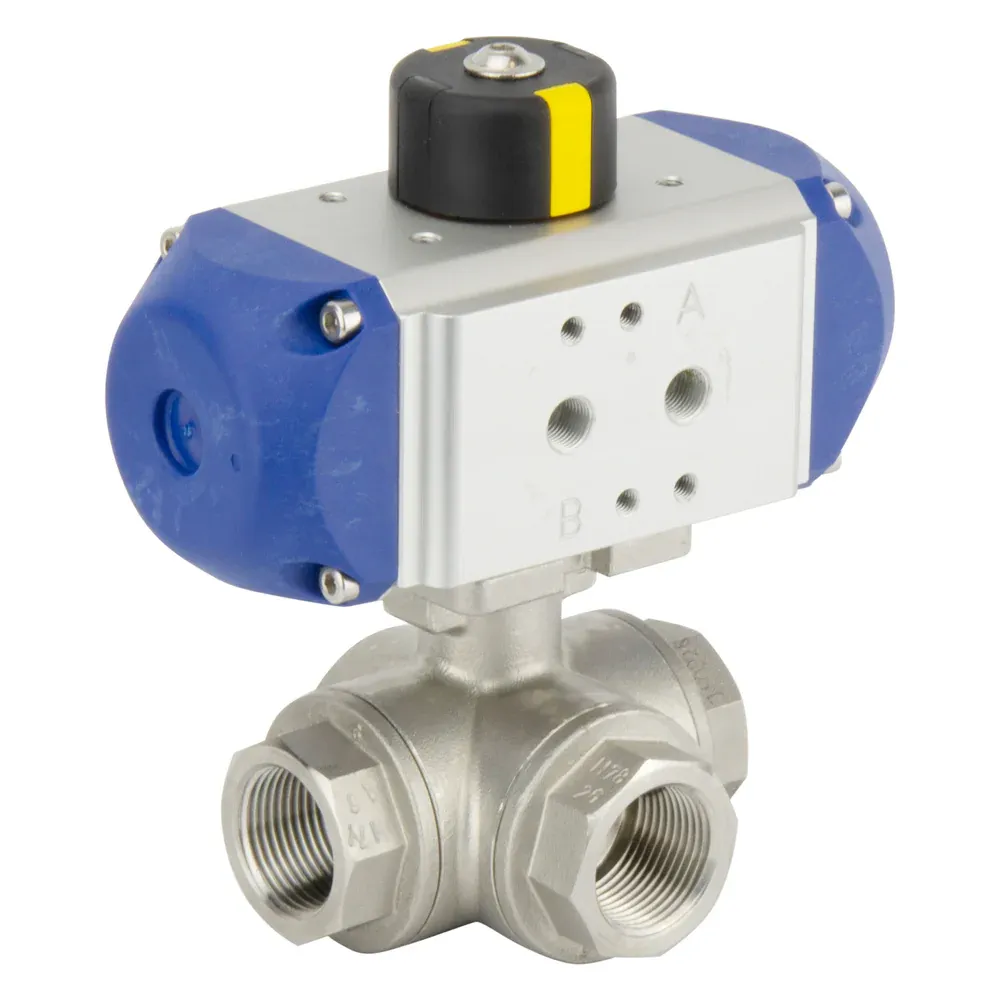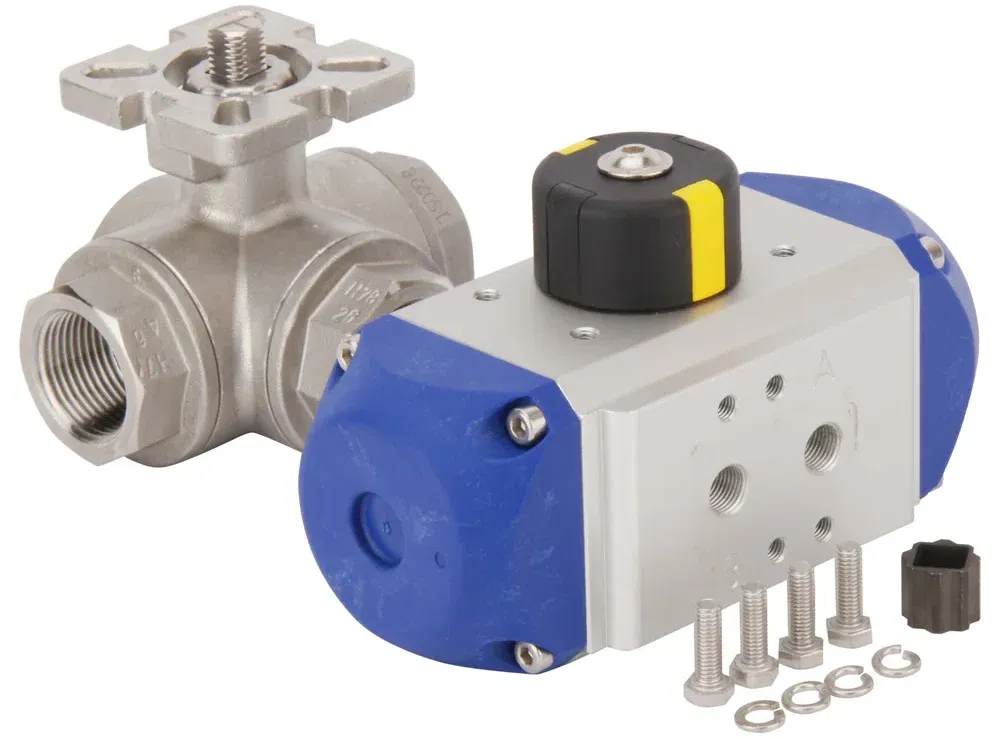
In modern industrial automation systems, pneumatic ball valves have become a crucial component due to their rapid actuation, efficiency, and ability to reduce labor demands. Unlike manually operated valves, pneumatic ball valves utilize compressed air to drive the actuator, enabling fast and accurate control over fluid flow. This not only boosts operational efficiency but also minimizes the need for manual intervention, saving both time and human resources.
Pneumatic ball valves are an evolution of plug valves, retaining the rotational motion mechanism while replacing the cylindrical plug with a sphere. This spherical component contains a central through-hole that aligns with the flow direction when in the open position. When the ball is rotated 90 degrees, the hole turns perpendicular to the flow path, effectively blocking the passage and stopping the fluid flow. This simple yet effective mechanism makes pneumatic ball valves suitable for a wide range of applications in industries such as oil and gas, chemical processing, water treatment, and power generation.
However, the reliability of a pneumatic ball valve depends heavily on its sealing performance. The ability of the valve to maintain a tight seal under various operating conditions is fundamental to preventing leaks, maintaining process integrity, and ensuring safety. This article explores the key factors influencing the sealing performance of pneumatic ball valves, including the design and material of the sealing pair, as well as the advantages that make them a preferred choice in industrial settings.

The sealing performance of a pneumatic ball valve is directly related to the shape and roundness of the ball. A perfectly spherical ball ensures uniform contact with the valve seat, which is crucial for achieving a tight seal. Any deviation in roundness, such as ovality or surface irregularities, can result in uneven contact, creating gaps through which fluid may leak. To mitigate this, high-precision machining processes such as CNC turning and lapping are employed during manufacturing to ensure that the ball conforms to strict geometric tolerances.
In high-performance pneumatic ball valves, the roundness of the ball is often maintained within micrometer-level tolerances. This level of precision ensures that the sealing contact is continuous and consistent across the entire surface, enhancing sealing reliability even under high pressure or temperature fluctuations.
Surface smoothness is another crucial factor affecting sealing performance. A finely finished sealing surface minimizes the presence of micro-gaps that can allow fluid leakage. Typically, the valve seat and the ball are machined to a mirror-like finish, with a surface roughness (Ra) of less than 0.2 µm for high-grade valves. This level of smoothness enhances contact between the two surfaces, ensuring a tight, leak-proof seal.
Surface finish also plays a role in reducing wear and friction between the ball and the seat. A smoother surface generates less resistance during valve operation, contributing to longer service life and reduced maintenance requirements.
Material selection for the sealing components—the ball and seat—is a critical factor in determining the valve’s sealing effectiveness and durability. These materials must be compatible with the process medium and operating conditions, including pressure, temperature, and chemical exposure.
Soft Sealing Materials: Materials like PTFE (polytetrafluoroethylene), reinforced PTFE (RPTFE), and other elastomers provide excellent sealing due to their flexibility and compressibility. They are ideal for low to medium-pressure applications but may degrade at high temperatures or in chemically aggressive environments.
Metal Seals: For high-temperature or abrasive conditions, metal-to-metal seals made from stainless steel, Inconel, or other corrosion-resistant alloys are preferred. While metal seals are more robust, they require precise machining and are typically used in severe service applications where soft seals would fail.
Composite Materials: In some designs, a combination of soft and hard materials is used to balance sealing performance with durability. For example, a metal seat may be coated with a soft sealing material to provide both resilience and wear resistance.
Selecting the right sealing material based on the application's temperature range, chemical exposure, and required sealing tightness is essential for ensuring long-term performance.
In addition to their sealing characteristics, pneumatic ball valves offer several structural and operational advantages that make them highly effective in industrial systems.
Among all valve types, ball valves exhibit the lowest flow resistance. When fully open, the through-hole in the ball aligns perfectly with the flow path, allowing fluid to pass with minimal turbulence and pressure drop. This makes them especially suitable for applications where energy efficiency and flow control are critical.
Pneumatic ball valves are designed with thrust bearings that significantly reduce the friction between the valve stem and the actuator. This reduces the operating torque, allowing the actuator to operate smoothly and with less air consumption. Reduced torque also contributes to longer service life of both the valve and the actuator.
Pneumatic ball valves often use PTFE or similar materials for the valve seat. These materials provide elastic deformation that enhances sealing as the internal pressure increases. The higher the pressure, the more tightly the seat presses against the ball, improving the sealing effect and minimizing the chance of leaks.
The valve stem in pneumatic ball valves typically operates with a rotary motion, minimizing the stress on the packing material. Because the stem does not move axially, the chances of packing degradation are significantly reduced. Furthermore, as the internal pressure increases, the packing compresses further, enhancing the stem’s sealing capability. Some designs also incorporate double O-ring or bellows seals for additional protection.
Materials like PTFE used in the valve seats have excellent self-lubricating properties. This reduces friction between the seat and the ball during operation, leading to less wear and tear. Additionally, the minimal contact area and reduced operating force result in lower mechanical stress, which translates to extended valve life even in frequent cycling applications.
For safety, most pneumatic ball valves incorporate a bottom-mounted stem design. The stem is inserted from inside the valve body and held in place by a step or shoulder, preventing it from being ejected under pressure. This design is especially important in high-pressure systems or in the event of fire damage, where seal degradation could otherwise cause the stem to be pushed out, creating a severe safety hazard.
In some applications, particularly where flammable fluids are involved, static electricity buildup can be a hazard. Pneumatic ball valves with anti-static devices—such as conductive springs between the ball, stem, and body—ensure continuous electrical conductivity. This safely dissipates any static charges that may accumulate during valve operation, preventing potential ignition of flammable gases or liquids.
To ensure optimal sealing performance in real-world conditions, several application-specific factors should be considered when selecting and installing pneumatic ball valves:
Though ball valves can operate in any orientation, certain configurations may benefit from installing the valve in a particular direction to minimize sediment accumulation or ensure proper actuator alignment.
For corrosive, abrasive, or high-temperature environments, materials must be selected accordingly. For instance, using Hastelloy or duplex stainless steel can prevent corrosion-related sealing failures.
In applications where the valve cycles frequently, such as in automated process systems, materials with high wear resistance should be chosen to ensure longevity and reliable sealing over time.
Pressure and Temperature Fluctuations: Applications with dynamic pressure and temperature changes may benefit from metal or composite seals that maintain their sealing integrity under stress.
Preventive Maintenance: Regular inspection and maintenance of sealing surfaces and actuators can help detect wear or damage early, preventing unexpected leakage or failure.
Pneumatic ball valves offer a highly efficient, reliable, and safe solution for controlling fluid flow in a wide range of industrial applications. Their sealing performance is influenced by multiple factors, including the precision of the ball's geometry, the smoothness of the sealing surfaces, and the material selection for the ball and seat. By optimizing these factors, manufacturers can produce valves that provide exceptional sealing performance, even under challenging conditions.
Beyond sealing, pneumatic ball valves also offer numerous operational advantages: low flow resistance, reduced friction and operating torque, long service life, reliable stem sealing, and safety features such as blowout-proof stems and anti-static designs. These characteristics make them an ideal choice for automated systems where precision, safety, and durability are critical.
As technology and manufacturing processes continue to evolve, the sealing performance of pneumatic ball valves is expected to improve further, supporting increasingly complex and demanding industrial processes.